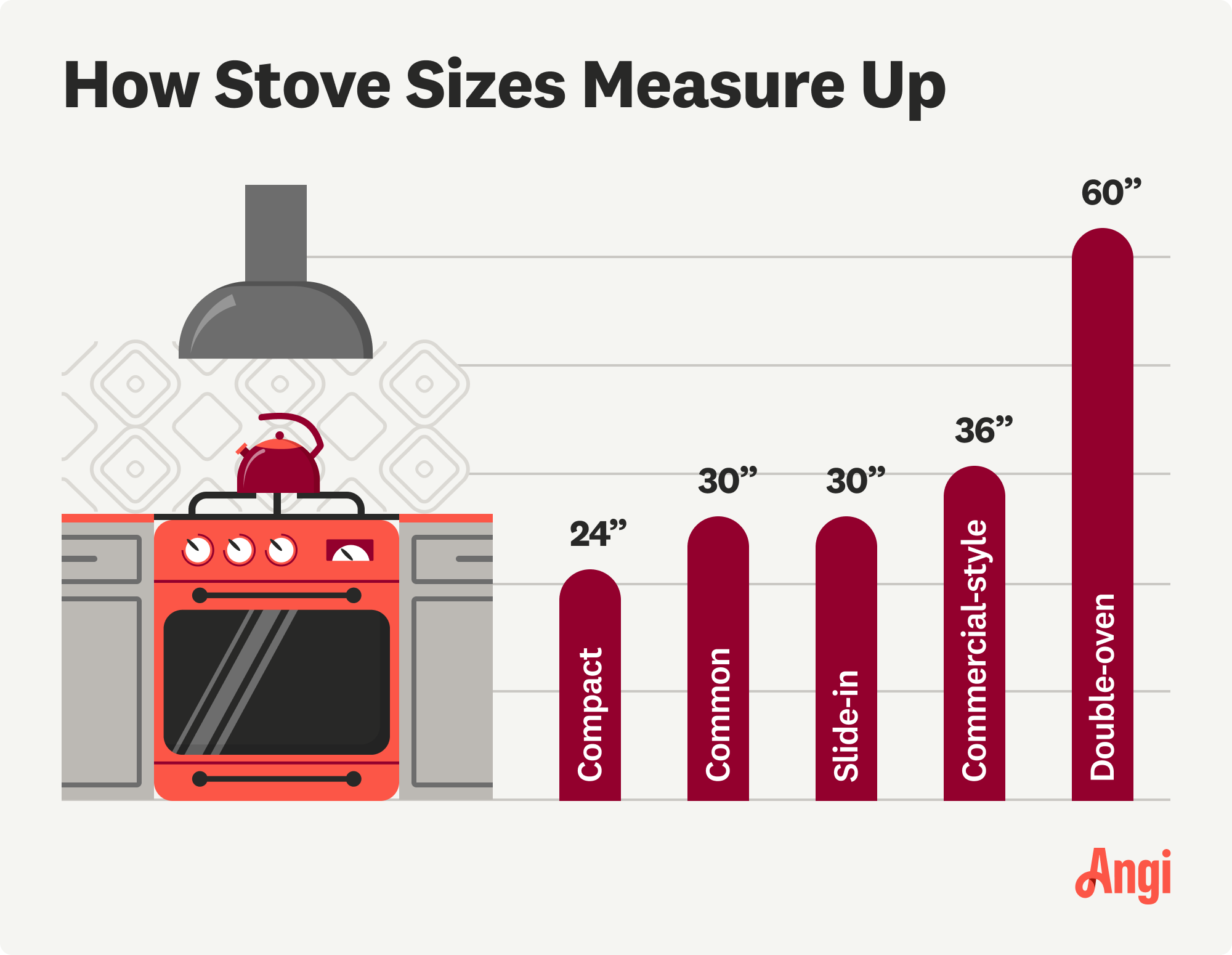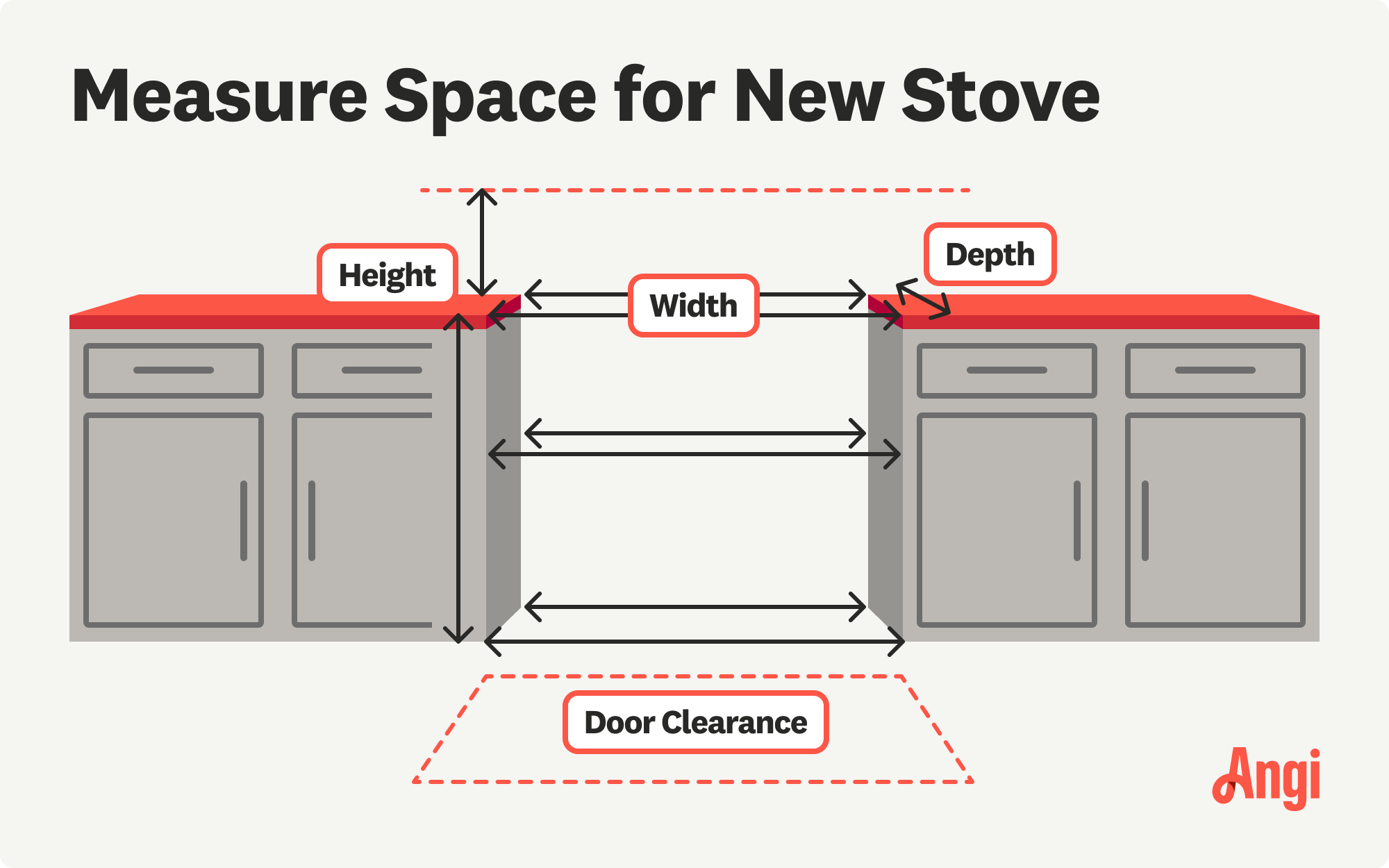
Replacing a dryer belt costs more than just the part unless you can DIY it. The labor cost can easily surpass 90% of the product cost, so if you are handy with tools, try it yourself first.
Not all stoves (sizes) are created equal


Multiple stove sizes are available to fit certain circumstances.
The most common stoves measure 30 inches in width.
Compact stoves can measure as little as 20 inches in width.
Double-oven stoves can measure as wide as 60 inches.
When buying a new stove, must-have features and design elements are at the top of the list. But have you thought about stove dimensions? Imagine finding the perfect stove only to find out that it won’t fit between the cabinets. An ideal stove is one that fits your kitchen space perfectly. Read on to better understand how to measure your kitchen so that standard stove dimensions align seamlessly with the rest of the space.

Standard stove dimensions apply to the majority of these appliances. These are the common stove measurements:
36 inches in height
30 inches in width
25 to 27 inches in depth
These measurements exclude handles, knobs, or control panels.
Keep in mind, the front of the stove will likely protrude a few inches past the front edge of the surrounding cabinets.
While the terms oven, range, and stove, are often used interchangeably, they are different. Range and oven refer to units with both an enclosed cavity and an open-air cooking surface. Stove refers solely to an enclosed cavity (wall ovens) and stovetop, or cooktop, refers solely to an open-air cooking surface.
If you have a small space that will not accommodate a range with standard stove dimensions, select a small, compact stove. This appliance typically measures:
36 to 41 inches in height
20 to 24 inches in width
25 to 27 inches in depth
Even though it uses a narrow design, the small stove tends to be taller than average and can offer a bit more oven capacity.

If you need a larger stove—something like those in a professional—kitchen, you can purchase a commercial-style stove that’s made for residential use. This larger stove would typically measure:
36 inches in height
30 to 36 inches in width
25 to 30 inches in depth
These stoves often have an extra set of burners and a spacious oven.
If you need to have two separate oven sections in your stove, so you can bake multiple items simultaneously at different temperatures, select a double-oven range. Its dimensions typically measure:
36 inches in height
48 to 60 inches in width
25 to 30 inches in depth
For a stove that fits perfectly within your remodeled kitchen, you may want a slide-in model. This stove fits flush with countertop height. It doesn’t have a backguard or protruding back control panel, so it shouldn’t hide the existing backsplash. It may also have a built-in downdraft ventilation system, negating the need for a vent hood.
Slide-in stove dimensions typically measure:
36 inches in height (or whatever matches the height of the countertop)
30 to 60 inches in width
25 to 27 inches in depth
Should you decide to go with a slide-in stove, select the model you want before the local kitchen remodeler draws up the plans. The remodeler can then create a space for the stove and configure the cabinets and backsplash to accommodate the new slide-in stove.
Stove manufacturers round the size of the stove to avoid fractions. A 30-inch-wide description printed in the marketing materials may actually measure 29-⅞ inches in width in real life, for example. Don’t worry about rounding, as the listed stove dimensions equal the space you need for the cutout.

When cabinets are already in place and there is a spot for the stove, measure the existing space before selecting a new stove. Use a tape measure for an accurate measurement. If you have a stove in place already, move it out of the way before measuring.
Measure the opening between the cabinets with the tape measure. Write down the space between cabinets at the top, middle, and bottom, as well as at the front and back. You need to find the narrowest measurement, even if that is between the countertop pieces that overhang the open cutout for the stove.
Use the tape measure to determine the depth–measure from the back wall to the front edge of the cabinets. This measurement is particularly important if you don’t want the stove to jut out and align with the front of the cabinets.
Regardless of whether you are installing a gas vs. electric stove, leave a couple of inches at the back to accommodate the 220-volt electrical outlet or the gas line connector. Since the free space needed is similar for either type of stove, converting an electric stove to gas or vice versa requires a similar measuring process.
However, keep in mind that some gas stove manufacturers require at least a 3-inch gap from the back wall to the stove—something to remember if you want to know how to install a gas stove. If you must install a new gas line in the space available, make sure the local appliance installer follows the gas stove manufacturer’s recommendations for the size of the gap. Gas stove installation costs can run between $75 to $100 per hour, should you need to run a new line.
You typically need at least 2 feet between the top of the cooking surface and whatever is above it–a vent hood, built-in hanging microwave, or a pot filler over the stove. This distance protects the items above the stove from heat damage. Check to see if local building codes require more than 2 feet.
For a space with a kitchen island directly across the stove, be sure to measure the depth of the stove with the oven door open. The door should open completely without hitting the island. Ideally, the space between the open oven door and the island should have at least a foot of clearance to allow freedom of movement and ease of access as you reach inside the oven.
The right size stove for you depends on several factors, including your cooking needs and kitchen space.
First and foremost, consider your cooking needs and style. If you have a big family, like to entertain guests, or just cook lots of stovetop dishes at once, then a stove big enough to accommodate five burners or more is a great option. Many 36-inch stoves meet this need.
Average households do well with standard 30-inch stoves, which often have four burners, while very small households might only need 20-24-inch stoves, which often have two to four burners.
Before making any stove decisions, ensure you measure the width, depth, and height of the space where the stove will live. There should be adequate clearance around the stove for proper safety and ventilation. The right clearance can depend on the stove, so check the manufacturer’s recommendations for each prospective stove to determine exactly how much clearance you’ll need.
You should also consider the oven’s capacity before deciding on a stove. Typically, the bigger the stove, the bigger the oven. If you love to bake or have a large family, you may want to go with a larger stove with a similarly large oven. You could even consider a stove with a double oven so you can cook multiple dishes at once.
From average costs to expert advice, get all the answers you need to get your job done.

Replacing a dryer belt costs more than just the part unless you can DIY it. The labor cost can easily surpass 90% of the product cost, so if you are handy with tools, try it yourself first.

Discover the average dishwasher installation cost, key price factors, and tips to save on your project. Get transparent, expert-backed estimates.

Range hoods come in various styles and help keep your kitchen clear of odors, smoke, and grease. Here’s how much it costs to install a range hood by type.

Looking for a new washer or dryer to keep your clothes fresh and clean? Learn how to choose a washer and dryer by knowing what to consider.

Your gas stove may not light for a number of reasons, including problems with the safety valve or igniter. Learn how to troubleshoot why your gas stove is not lighting.

Refrigerators comprise many different parts. Understanding what they are and how they function will help you maintain it and troubleshoot problems.